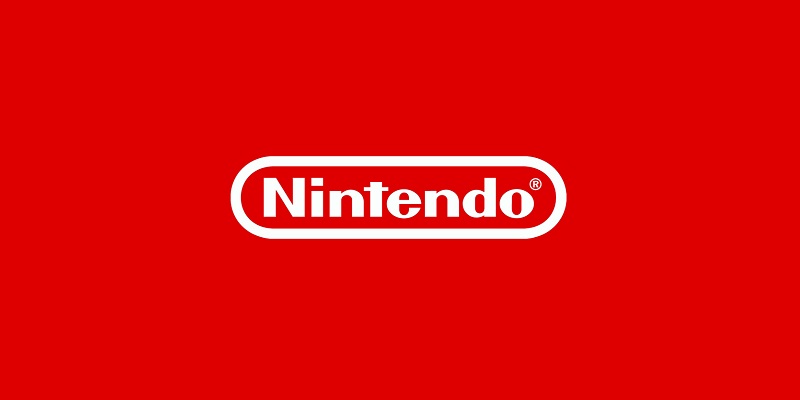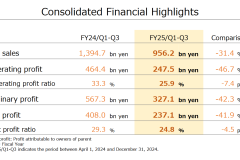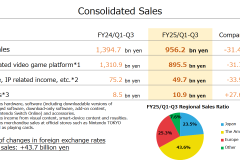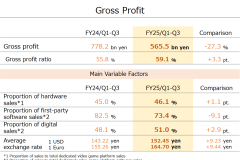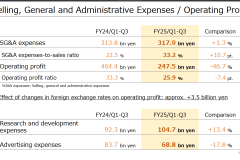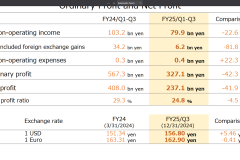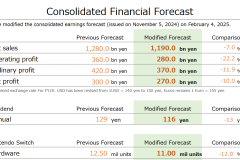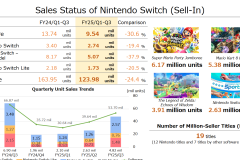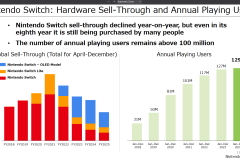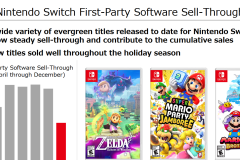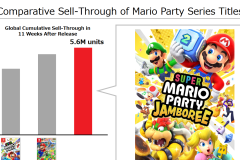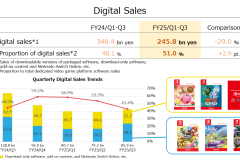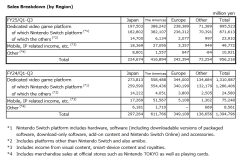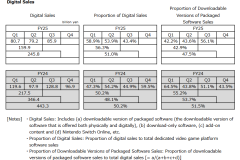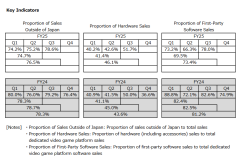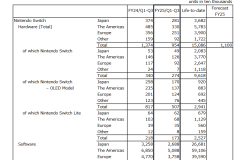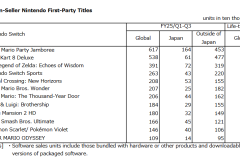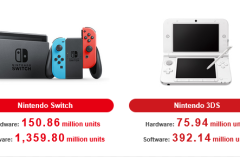Nintendo Financials (February, 2025): results and highlights, Investors Briefing, Q&A
Nintendo Financials – Results
Today, Nintendo shared its latest financial results, covering the period ended December 31st, 2024 (April 1st 2024 to December 31st 2024). You will find all the details on these pages:
- Consolidated Financial Highlights, with consolidated operating results, the forecast for the current Fiscal Year, Nintendo comments, sales information (regional breakdown, digital sales), sales data and forecast, and more
- Financial Results Explanatory Material, with lots of additional sales data, the list of million-sellers this Fiscal Year, the upcoming releases planning, and more
Some highlights:
- The Legend of Zelda: Echoes of Wisdom has sold 3.91 million units since launch, with 1.32 million units sold during Q3 of the current Fiscal Year;
- Super Mario Party Jamboree is off to a strong start with no less than 6.17 million units sold during its launch quarter;
- Mario Kart 8 Deluxe just keeps on trucking along with 5.38 million units sold this Fiscal Year (+3.07 million units in Q3 of the current Fiscal Year alone), which brings total sales to 67.35 million units;
- This Fiscal Year, a total of 19 games sold over 1 million units;
- Nintendo Switch (Hardware): 9.54 million units sold this Fiscal Year (+4.82 million units during Q3), a 30.6% drop Year on Year;
- Nintendo Switch (Software): 123.98 million units sold this Fiscal Year (+53.7 million units during Q3), a 24.4% drop Year on Year;
- Both Hardware and Software saw a substantial drop in sales compared to the same period last year, which is partly due to the strong impact The Legend of Zelda: Tears of the Kingdom and Super Mario Bros. Wonder had. Still, sales remain rather strong for a platform in its 8th year (and with the successor on the horizon);
- Digital sales: 245.8 billion Yen (+85.9 billion Yen during Q3), a 29% drop Year on Year mainly due to a decrease in the sales of digital version of retail games;
- Mobile and IP related business: 49.7 billion Yen (+18.5 billion Yen during Q3), a 33.9% drop Year on Year due to a decrease in revenue related to the Super Mario Bros. Movie (which had a strong impact last year).
- Both Hardware and Software sales during Q3 were below expectations, and so it’s no wonder that Nintendo revised the financial forecast for the full Fiscal Year downward a second time (after a first revision in November). That being said, the reevaluation of the assumed exchange rate is another reason the forecast was changed this time.
Here’s sales data for some games (courtesy of Mazi):
- Mario Kart 8 Deluxe – 67.35M (+3.08M)
- Super Mario Bros. Wonder – 15.51M (+2.07M since March 31st 2024)
- Super Mario Party Jamboree – 6.17M
- Mario & Luigi: Brothership – 1.84M
- Nintendo Switch Sports – 15.74M (+1.37M)
- The Legend of Zelda: Echoes of Wisdom – 3.91M (+1.33M)
- Animal Crossing: New Horizons – 47.44M (+990K)
- Super Smash Bros. Ultimate – 35.88M (+740K)
- Pokémon Scarlet and Violet – 26.38M (+690K)
- Super Mario Odyssey – 29.04M (+540K)
- The Legend of Zelda: Tears of the Kingdom – 21.55M (+510K)
- The Legend of Zelda: Breath of the Wild – 32.62M (+330K)
- New Super Mario Bros. U Deluxe – 18.06M (+290K)
- Luigi’s Mansion 2 HD – 1.80M (+230K)
- Pokémon Sword and Shield – 26.60M (+160K)
- Super Mario Party – 21.10M (+120K)
- Paper Mario: The Thousand-Year Door – 2.06M (+120K)
The following pages were also updated:
- Dedicated Video Game Sales Unit: Hardware and Software sales for Nintendo consoles
Top Selling Title Sales Units: Top 10 Software for each platforms:
- Nintendo Switch [Updated]
- Nintendo 3DS
- Wii U
- Nintendo DS
- Wii
Nintendo Financials – Briefing
The full transcript of the Third Quarter Financial Results Briefing is now available: click here to check it out!
Nintendo Financials – Q&A
The transcript of the Q&A session is now available in English: click here to check it out! Here’s the list of questions:
Question 1: I’d like to hear the reasons for the downward revision of your full-year financial forecast. Were there any special factors, such as consumers holding off on purchases following the announcement of Nintendo Switch 2, the successor to Nintendo Switch?
Question 2: What was the reaction from consumers and software publishers after the announcement of Nintendo Switch 2 and the release of the promotional trailer?
Question 3: I would like to hear Nintendo’s thoughts on pricing products. Given the recent inflation and exchange rate situation, and the resulting price difference between Japan and outside markets, has your thinking changed regarding what price ranges would be acceptable to consumers for Nintendo Switch and Nintendo Switch 2?
Question 4: Regarding the revision of the full-year financial forecast, why is the sales volume for software during the fourth quarter (January-March 2025) much lower than the sales results we have seen in other quarters? Was there a significant change in momentum after the holiday season, or did you set a conservative forecast?
Question 5: What do you perceive to be the current position of smart devices in Nintendo’s business, and what are your plans for them going forward? You have not released any new game apps recently, but you have started providing the Nintendo Music audio streaming service for Nintendo Switch Online members, and Everybody 1-2-Switch! utilizes smart devices as controllers. So it looks like rather than releasing standalone game apps, you intend to incorporate smart devices into gameplay. In the past, people’s first game devices were Nintendo hardware, but that has now changed to be a smart device instead. Please share your insights into this situation.
Question 6: Last year, you stated that you would produce enough Nintendo Switch 2 systems to satisfy the initial demand. Does this plan remain unchanged? For Nintendo Switch, you had difficulties ramping up production to meet the sharp increase in demand post-launch. Do you think that would be a concern for Nintendo Switch 2?
Question 7: In the third quarter of each year, shipments are made in preparation for the holiday season, so inventory tends to decrease compared to the end of the second quarter. However, inventory at the end of this third quarter (end of December 2024) increased compared to the end of the second quarter (end of September 2024). I would like to know the reason for this increase in inventory. Is it because inventory related to Nintendo Switch is accumulating due to slower
sales during the holiday season, or is inventory increasing because you are preparing to ship out Nintendo Switch 2? If the increase is due to Nintendo Switch 2 related inventory, what would be an approximate maximum number of Nintendo Switch 2 units shipped in the first
fiscal year?
Question 8: Can you provide background for the downward revision of your full-year Nintendo Switch software unit sales forecast? Did you revise your full-year sales forecast due to sales of new first-party titles falling short of expectations?
Question 9: Last October, recruitment of participants began for the Nintendo Switch Online: Playtest Program to test a new service for Nintendo Switch Online. How is this new initiative going? Also, please tell us your thoughts on future online strategy for Nintendo Switch 2.
Question 10: Many people are still purchasing Nintendo Switch. Although its successor, Nintendo Switch 2, was announced, some people may have purchased Nintendo Switch in the hope that new titles for the system will continue to be announced in the future. Will there be many new titles released for Nintendo Switch in 2025 and later, or will evergreen titles constitute the core of Nintendo Switch offerings?

